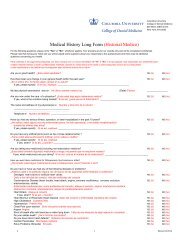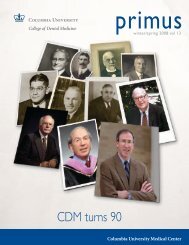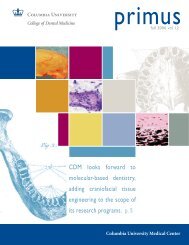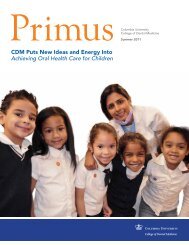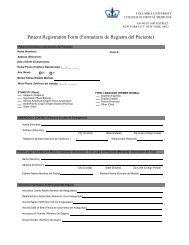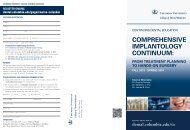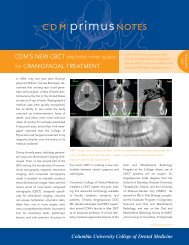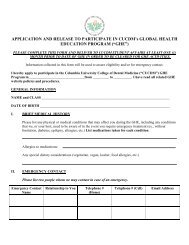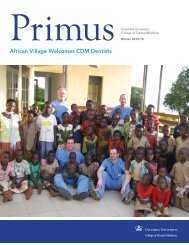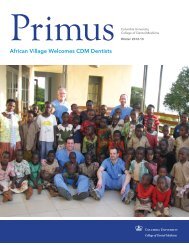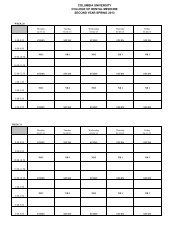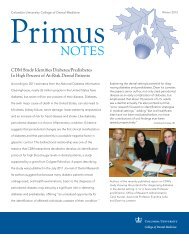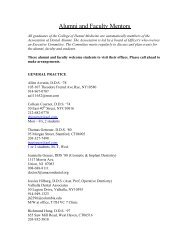Jarvie Journal - College of Dental Medicine - Columbia University
Jarvie Journal - College of Dental Medicine - Columbia University
Jarvie Journal - College of Dental Medicine - Columbia University
You also want an ePaper? Increase the reach of your titles
YUMPU automatically turns print PDFs into web optimized ePapers that Google loves.
The <strong>Journal</strong> <strong>of</strong> the William <strong>Jarvie</strong> Society<br />
The Effectiveness <strong>of</strong> an Interactive Oral Health Promotion Video in a<br />
Pediatric Clinic Waiting Room<br />
Jeffrey Fong 1 , Courtney H. Chinn 2*<br />
1 <strong>Columbia</strong>-New York Presbyterian Hospital, Residency Program in Pediatric Dentistry, 2 Section <strong>of</strong> Social &<br />
Behavioral Sciences; both within <strong>Columbia</strong> <strong>University</strong> <strong>College</strong> <strong>of</strong> <strong>Dental</strong> <strong>Medicine</strong>, New York, NY; * Faculty<br />
Mentor<br />
Introduction: Patient waiting rooms can be an effective setting for delivering health information.<br />
Several studies performed in emergency department waiting rooms have shown improvements in<br />
knowledge after watching a health education video. Despite a wealth <strong>of</strong> education materials, there is<br />
little research on the efficacy <strong>of</strong> audio-visual materials in educating parents on pediatric oral health<br />
(“POH”). Several studies have questioned the value <strong>of</strong> POH handouts and videos versus motivational<br />
interviewing (“MI”). Harrison et al. (2007) showed a 46% lower rate in dmfs after 2 years in a MI group<br />
versus a group <strong>of</strong> parents who were given a POH pamphlet and video.<br />
Objective: To determine if a bilingual interactive oral health promotion video (“IOHPV”) will<br />
significantly improve parents’ knowledge and attitudes regarding POH.<br />
Materials & Methods: Over 4 months, an IOHPV and control (Disney video) was shown on alternating<br />
months in the pediatric medical clinic waiting room at NY Presbyterian Hospital’s Audobon Primary<br />
Care Practice. During this time, parents <strong>of</strong> pediatric patients presenting for medical care completed a<br />
questionnaire, which included questions on demographics, knowledge (total <strong>of</strong> 10 questions on age 1<br />
visit, fluoride, toothbrushing, nutrition, and caries management) and attitudes about POH. Data was<br />
analyzed using a commercial s<strong>of</strong>tware package (PASW).<br />
Results & Conclusions: 155 subjects (57%) and 115 controls (43%) participated in the study (N = 270).<br />
70% (N = 188) <strong>of</strong> subjects were Hispanic and 57% (N = 154) mainly spoke Spanish. 46% (N = 123) <strong>of</strong><br />
parents reported their child saw the dentist within the last year. Overall, parents correctly answered 57%<br />
<strong>of</strong> POH knowledge questions. No significant differences in mean knowledge or attitude scores were<br />
found between subjects watching the IOHPV and the control, nor was there a difference by race <strong>of</strong><br />
parent or age <strong>of</strong> patient. However, there was a significant difference in total knowledge score by report<br />
<strong>of</strong> dental visit with parents who took their child to see a dentist within the last year scoring significantly<br />
higher compared to those who did not.<br />
Discussion: The IOHPV was specifically designed to engage parents that presented to the pediatric<br />
medical clinic in the Washington Heights neighborhood <strong>of</strong> Manhattan. However, results show that<br />
parents who saw the control video had higher knowledge scores than those who saw the IOHPV. One<br />
consideration was the operational design <strong>of</strong> the waiting room which may have impeded parents from<br />
watching and hearing the IOHPV. The waiting room was large, busy and loud. Parents may have been<br />
occupied with their child(ren) and not all chairs were facing one <strong>of</strong> the two televisions. An encouraging<br />
finding was that parents who took their child to the dentist in the last year scored significantly higher<br />
than parents who did not. Engaging with a dental pr<strong>of</strong>essional may continue to play a vital role in<br />
improving parental POH knowledge.<br />
Research supported by the Health Resources and Services Administration Maternal and Child Health Bureau:<br />
Leadership Training in Pediatric Dentistry Grant T17MC06359<br />
Post-doctoral Training in Pediatric Dentistry Grant D88HP20109<br />
58



